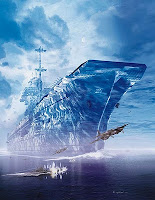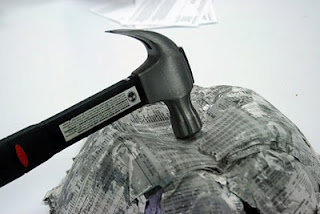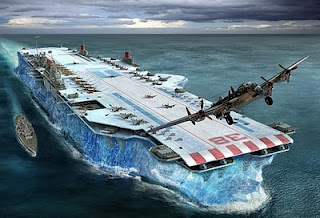During World War II, some of the best and brightest minds of the British Royal Navy were hard at work figuring out how to make ice. Well, not just any ice. An ice stronger than ice – in fact, almost as strong as concrete! The material was called pykrete, and although it was successfully invented and tested, it was never actually used.
Pykrete was conceived by Geoffrey Pyke, an English journalist and inventor in the early 20th century. Inspired by his battles with ice and snow during the invasion of Norway, Pyke mulled over the uses of ice and super-cooled water. What he came up with was a fleet of gigantic aircraft carriers made of ice, capable of launching fighters and bombers. These massive structures were intended to serve logistically as mobile launching points – floating islands, if you will.
The obvious problem with carving a ship out of ice is that it will melt. You might also guess that a few enemy bullets would go a long way toward breaking it down or at least helping it tip. The solution? Mix the water with wood pulp before freezing. Amazingly, this paper-ice, initially called piccolite, became so much more than ice. Early tests suggested that even in ratios of 4% wood pulp to 96% water, the resulting piccolite was, weight for weight, as strong as concrete. The addition of the pulp also greatly lowered the material’s thermal conductivity, causing it to melt much, much more slowly. No more melting ships!
The engineers in the project (codenamed Habakkuk) eventually settled on a mixture of 14% pulp to 86% water and renamed the material, “Pykrete.” The figures they gave for its durability astounded:
- Crushing strength: 1,100 psi (Concrete: 2,500 psi)
- Tensile strength: 700 psi (Concrete: 200 psi)
- Density: 0.98 g/cm3 (Concrete: 2.5 g/cm3)
Some (unsupported) sources place pykrete’s compressive strength at up to 3,000 psi, making it supposedly fully stronger than concrete by both measures of strength. The story is told that a bullet was fired into a block of ice, which shattered, and then into a block of pykrete to demonstrate its strength. The bullet allegedly ricocheted off the block and grazed the observing Admiral!
Unfortunately, by the time the process was documented and these massive pykrete carriers could be built to float across the sea as cheap and impervious islands, the Atlantic Gap was closed, making the structures largely unnecessary. The technical difficulties in constructing such super-massive ships with ice had also discouraged project leaders.
Regardless of its abandonment, I must say I’m astonished at the concept. Maybe someone will someday find a use for this crazy, cheap, but very effective material. What are your thoughts?
Comment and share to keep the discussion going. And subscribe via RSS or Email if you like this blog!
Photo credits: Art courtesy Dominic Harman

 During World War II, some of the best and brightest minds of the British Royal Navy were hard at work figuring out how to make ice. Well, not just any ice. An ice stronger than ice – in fact, almost as strong as concrete! The material was called pykrete, and although it was successfully invented and tested, it was never actually used.
During World War II, some of the best and brightest minds of the British Royal Navy were hard at work figuring out how to make ice. Well, not just any ice. An ice stronger than ice – in fact, almost as strong as concrete! The material was called pykrete, and although it was successfully invented and tested, it was never actually used.

2 pings